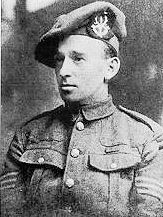Alexander Edwards facts for kids
Quick facts for kids
Alexander Edwards
|
|
|---|---|

Sjt. Alexander Edwards, V.C.
|
|
| Born | 4 November 1885 Stotfield, Lossiemouth, Moray, Scotland |
| Died | 24 March 1918 (aged 32) Bapaume Wood, near Arras, France |
| Buried |
Remembered on the Arras Memorial
|
| Allegiance | |
| Service/ |
|
| Years of service | 1914 – 1918 |
| Rank | Sergeant |
| Unit | 1/6th (Morayshire) Bn, the Seaforth Highlanders, 51st Highland |
| Battles/wars | First World War |
| Awards | Victoria Cross |
Alexander Edwards (4 November 1885 – 24 March 1918) was a brave Scottish soldier. He received the Victoria Cross, which is the highest award for courage in battle for British and Commonwealth forces.
Contents
Early Life and Joining the Army
Alexander Edwards was born in a place called Stotfield, near Lossiemouth in Morayshire. His father was a fisherman. Alexander grew up to become a cooper, which means he made wooden barrels, often for the herring fishing industry.
When World War I began, Alexander joined the army. On 1 September 1914, he became part of the 6th (Morayshire) Battalion of the Seaforth Highlanders. This unit was part of the 51st (Highland) Division. After training in Bedford, England, his battalion went to France in May 1915 to fight in the war.
A Heroic Act: Winning the Victoria Cross
By 1917, Alexander Edwards was a sergeant. He showed amazing bravery during the Battle of Pilckem Ridge on 31 July 1917. This battle was the first day of the larger Battle of Passchendaele.
Here's what happened:
- He found an enemy machine gun hidden in a wood.
- He bravely led his men to attack it.
- They managed to kill the enemy soldiers and capture the machine gun.
Later, an enemy sniper was causing problems for his company. Even though he was badly wounded in the arm, Sergeant Edwards crawled forward to find the sniper. He succeeded in killing the sniper.
At this point, only one officer was left in his company. Sergeant Edwards knew that capturing their final target was very important. Despite his serious wound, he led his men forward. They successfully captured their objective.
He then showed great skill in making sure their new position was safe. He also bravely went out alone to scout the area. The next day, he was wounded two more times. But he kept fighting and didn't worry about his own safety. His calm and determined actions inspired his men to fight bravely.
After his heroic actions, Sergeant Edwards returned to Britain. He received his Victoria Cross from King George V at Buckingham Palace on 26 September 1917. A week later, he was honored in his hometown of Lossiemouth. He received a gold watch and war bonds as gifts. Soon after, he went back to France to rejoin his unit.
A Sad End: The Last Battle
On 21 March 1918, the Germans started a major attack called the Kaiserschlacht (Spring Offensive). On 24 March, Sergeant Edwards was wounded and went missing in action. It was believed he was killed during the fighting at Bapaume Wood, east of Arras, France.
His body was never found. Sergeant Edwards is remembered at Bay 8 on the Arras Memorial in France.
In Lossiemouth, where he grew up, there is a sundial memorial. It honors Alexander Edwards and his cousin, Captain G.E. Edwards, who also died fighting with the 6th Seaforth during the war. Both of them used to work as Caddies at the local golf course when they were boys.
Where to See His Medal
Alexander Edwards' Victoria Cross medal is on display in Scotland. You can see it at The Highlanders Museum, which is located at Fort George in Inverness-shire.
Images for kids


